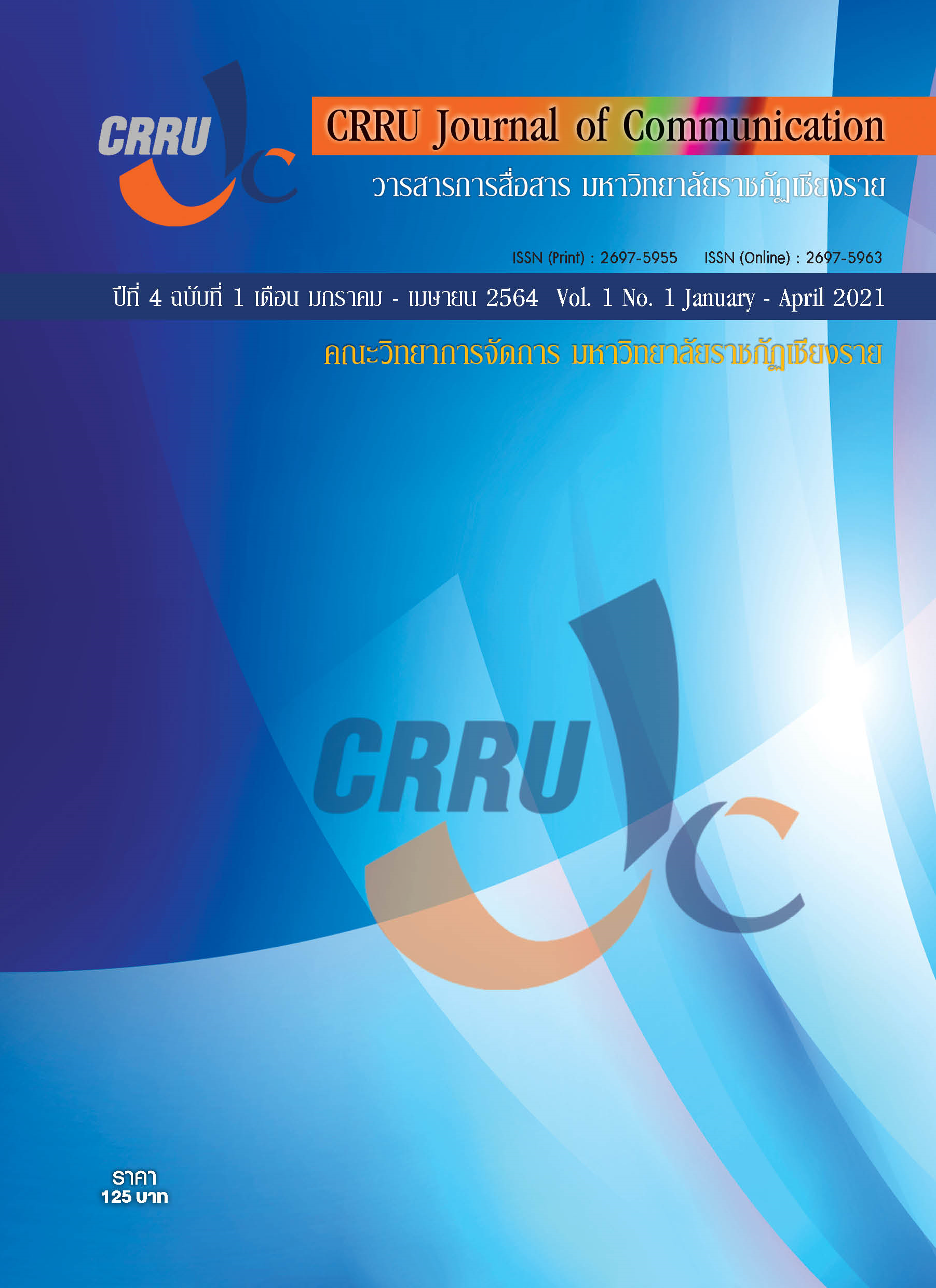The Intercultural Communication in the Variety of Ethnic Group : Case Study of Migration Place of Forest Repatriation Project at Wieng Raj Pree in Pa Sak Ngam Village, Moo 19, Dong Ma Ha Wan Sub district, Wieng Chiang Rung District, Chiang Rai Province
Main Article Content
Abstract
This research entitled “The Intercultural Communication in the Variety of Ethnic Group: Case Study of Migration Place of Forest Repatriation Project at Wieng Raj Pree Pa Sak Ngam Village, Moo 19, Dong Ma Ha Wan Sub-district, Wieng Chiang Rung District, Chiang Rai Province” aimed to survey basic information of ethnic group in the target area and to study intercultural communication in the variety of ethnic group in that area. The target area was the migration place for forest repatriation project and other reasons at Wieng Raj Pree community in Pa Sak Ngam Village, Moo 19, Dong Ma Ha Wan Sub-district, Wieng Chiang Rung District, Chiang Rai Province where there were many tribes of 303 households stayed here. The village committee grouped the sample groups based on the tribes consisted of 100 people of Hmong Mien, Lisu, Akha, Lahu, Pagayor, Yunan Chinese, and other tribes. The research instruments and methods were 1. an observation form and note-taking, 2. focus group from the committee of each tribe, and 3. a questionnaire made by the researcher.
The results of the study were concluded as follows:
- Most of the respondents or 39 percent were aged 15-30 years old.
- Most of the respondents or 34 percent were Hmong, and 15 percent was Akha respectively.
- Most of the respondents or 64 percent used central Thai in communication among the tribes.
- Most of the respondents or 46 percent had the problems in living in a community with multicultural communication and 38 % had the problem in the public utility.
- The questionnaire respondents had the problem in contacting people in the other tribes with a mean of 3.64 (SD 0.92), the problem of using language in communication with the mean of 3.50 (SD 0.81) respectively.
- The dialect of each tribe was used for communication with the mean of 3.53 (SD 0.78), while Central Thai and Northern dialect was used in communication with the mean of 3.51 (SD 0.99), respectively.
- The recommendations were found that there were some problems in communication between tribes, however, the solution was done by using Central Thai for communication among the tribe.
- The focus group on the communication process of each tribe in the community appeared that the social organization of each tribe by having the head who controlled the tribe and having the agreement for the community committee in terms of the communication within the community, the way to solve the problem, including finding the conclusion for the conflict of each tribe.
- The data analysis from the in-depth interview on intercultural communication in the variety of ethnic groups can be concluded that most of the villagers agreed that the public utility problem was the main problem more than the communication within the communication because there was the communication from the representatives who were the village committee.
- The data analysis from the observation on intercultural communication in the variety of ethnic groups was found that every tribe understood central Thai most but they preferred to use their dialect to communicate in their tribes. When compared to the communication problem, the new immigrants seem to have a communication problem in the adaptation period when compared with the ones who stayed there longer.
Article Details
References
กมลรัฐ อินทรทัศน์. (2561). ทฤษฎีการสื่อสาร. สืบค้นเมื่อ 20 ตุลาคม 2562, จาก https://pirun.ku.ac.th/~agrpct/envelop/com%20theory.doc.
กรอบความร่วมมือของประเทศในกลุ่มอนุภูมิภาคลุ่มน้ำโขง. (2553). สืบค้นเมื่อ 20 ตุลาคม 2562, จาก http://www.mekongchula.com/views/Mekong.
กระทรวงทรัพยากรธรรมชาติและสิ่งแวดล้อม. (2561). รายงานโครงการคืนผืนป่าให้แผ่นดิน , สืบค้นเมื่อ 20 ตุลาคม 2562, จาก https://gnews.apps.go.th/news?news=25026.
จีนฮ่อ. (2559). สืบค้นเมื่อ 2 พฤศจิกายน 2562, จาก https://th.wikipedia.org/wiki/ฮ่อ.
จังหวัดเชียงราย. (2557). สืบค้นเมื่อ 20 ตุลาคม 2562, จาก http://th.wikipedia.org/wiki/B2
ชาวเขาเผ่าต่าง ๆ ในไทย. (2559). สืบค้นเมื่อ 2 พฤศจิกายน 2562, จาก http://www.sawadee.co.th/thailand/hilltribes.
ชูศรี วงศ์รัตนะ. (2537). เทคนิคการใช้สถิติเพื่อการวิจัย. (พิมพ์ครั้งที่ 6). กรุงเทพมหานคร : ศูนย์หนังสือจุฬาลงกรณ์มหาวิทยาลัย.
นิษฐา หรุ่นเกษม. (2555). ทฤษฎีสื่อสารมวลชนกับสื่อใหม่. สืบค้นเมื่อ 30 ตุลาคม 2562, จากwww.milthailand.org/index.php?option=com_phocadownload.
ประทัย พิริยะสุรวงศ์. (2559). การพัฒนาใช้สื่อใหม่เพื่อการสื่อสารทางวัฒนธรรมของชนเผ่าอาข่ากรณีศึกษา บ้านแสนใจ อำเภอแม่ฟ้าหลวง จังหวัดเชียงราย. เชียงราย : มหาวิทยาลัย
ราชภัฏเชียงราย.
พีรยุทธ โอรพันธ์. (2556). ทฤษฎีการวิเคราะห์ข้อมูลงานวิจัยเชิงคุณภาพกรณีศึกษางานวิจัยเรื่อง : การสื่อสารระหว่างวัฒนธรรมของชาวไทยเชื้อสายมลายูและชาวมาเลเซียเชื้อสายไทย. เอกสารประกอบการบรรยายรายวิชาสัมมนาการสื่อสาร 1. พิษณุโลก . มหาวิทยาลัยนเรศวร.
ภัสรา ชนะชัย. (2550). แนวคิดและทฤษฎีการสื่อสาร. สืบค้นเมื่อ 25 ตุลาคม 2554, จากwww.multiply.multiplycontent.com.
Edward T.Hall. (1981). Beyond Culture. Anchor books. Doubleday.
Fidler, Roger. (1997). MediaMorphosis Understanding New Media. UK : Pine Forge Press.
Geert Hofstede & Gert Jan Hofstede. (2005) . Cultures and Organizations : Software of the mind. Revised and Expanded 2nd edition, The McGraw-Hill Companies.
Stephan Dahl. (2005). Intercultural Research : The Current State of Knowledge. Retrieved December 15, 2012, from http://papers.ssrn.com/sol3/papers.cfm ?abstract_id=658202.
Thomas J.Knutson. (2005). Tales of Thailand : Lesson from the land of smile. Retrieved October 10, 2012, form www.fulbrightthai.org/data/TALES/ THAILAND.doc.
Zolomoe (นามแฝง). (2555). New Media. สืบค้นเมื่อ 20 มีนาคม 2555, จาก http://zolomoe.exteen.com/20120617/traditional-media-new-media.


